Minimally Invasive Atrial Fibrillation Treatment
Atrial fibrillation (AF) is a type of arrhythmia, or abnormal heart rhythm.
In atrial fibrillation, the electrical signals from the upper chambers of the heart (the atria) are fast and irregular (Figure 1). This causes the atria to quiver instead of beating effectively.
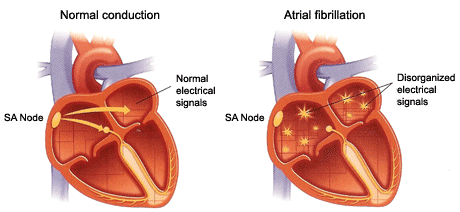 |
| Figure 1 |
Atrial fibrillation (AF) affects approximately 2.4 million Americans. People with AF are five to seven times more likely to have a stroke. At Robert Wood Johnson University Hospital, if AF cannot be treated with medication or other nonsurgical procedures, patients are referred for a minimally invasive Maze procedure.
This new procedure allows the surgeon to correct the electrical irregularity in the atria without performing open-heart surgery. With the minimally invasive Maze procedure, patients experience fewer potential complications and a much shorter hospital stay than with traditional open surgery.
The Minimally Invasive Maze Procedure
The minimally invasive Maze procedure takes two to three hours under general anesthesia during surgery.
First, an anesthesiologist inserts a breathing tube into the trachea (the airway from the mouth to the lungs). Through this tube, the right lung is deflated.
This allows the patient to breathe through the left lung, with ventilator assistance, while the surgeon accesses the heart. This way, the heart-lung bypass machine is not needed during surgery.
The surgeon then makes three small incisions on the right side of the chest (Figure 2).
Into one incision, the surgeon inserts a video camera. Through the other incisions, the surgeon opens the sac around the heart (the pericardium) and inserts the catheters around the heart (Figure 3).
Once these catheters are in place, the right lung is reinflated.
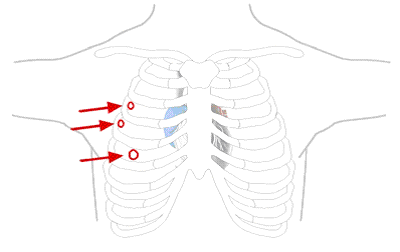 |
| Figure 2 |
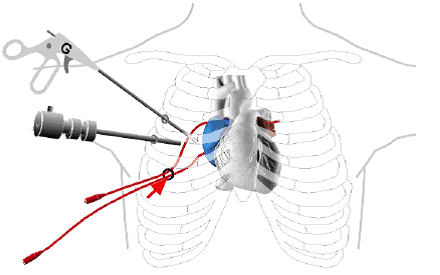 |
| Figure 3 |
The surgeon then makes three incisions on the left side of the chest, deflates the left lung, and inserts the camera and instruments. He opens the pericardium from the left side, retrieves the catheters, pulls them around the heart, and connects them at the left side. This forms a loop around the heart. (Figure 4)
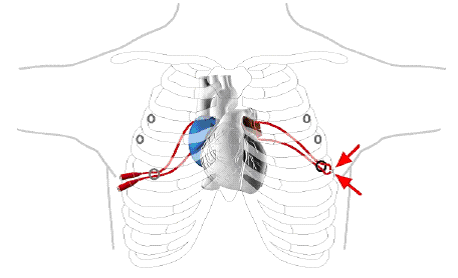 |
| Figure 4 |
Using the catheter loop as a guide, the surgeon then advances a microwave probe around the left atrium, at the base of the left and right pulmonary veins. When the probe is activated, the heat generated from it creates a lesion around the atrium. This is called ablation. (Figure 5)
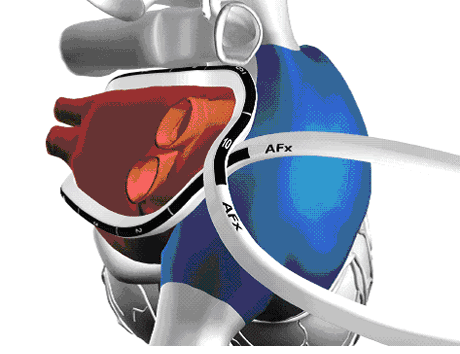 |
| Figure 5 |
The scar tissue that forms after the ablation prevents the abnormal electrical impulses from affecting the rest of the heart. After ablation, the surgeon reinflates the left lung, removes the instruments and camera, and closes and bandages all incisions.
Results: What to Expect After Surgery
In most cases, the breathing tube can be removed while the patient is in the operating room. After surgery, the patient will be moved to the intensive care unit (ICU). While in the ICU for six to eight hours, heart rhythm and other patient vital signs are monitored before the patient is moved to a regular hospital room for the night. Most patients are able to go home three days after surgery.
Once home, the patient should follow general health guidelines, including eating a heart-healthy diet. If there are no complications from surgery, the patient should be able to return to work in two to three weeks.
After surgery, the patient may still experience some symptoms of arrhythmia, such as heart palpitations or a lack of energy. This is because it takes up to six months for scar tissue to completely form after ablation.
The patient will return to the clinic for follow-up two, six and 12 weeks after surgery. At six months, the RWJUH team will evaluate whether normal heart rhythm has been restored.
Safety
Physicians at Robert Wood Johnson University Hospital, nationally renowned for the excellence of its cardiac programs, believe the minimally invasive surgery to treat atrial fibrillation has many advantages over other surgical methods of treatment. Traditionally, the surgical treatment for AF involves a major operation and recovery time is extensive. With minimally invasive surgery, outcomes are as effective as traditional surgery but with fewer complication risks than those associated with open heart surgery.



